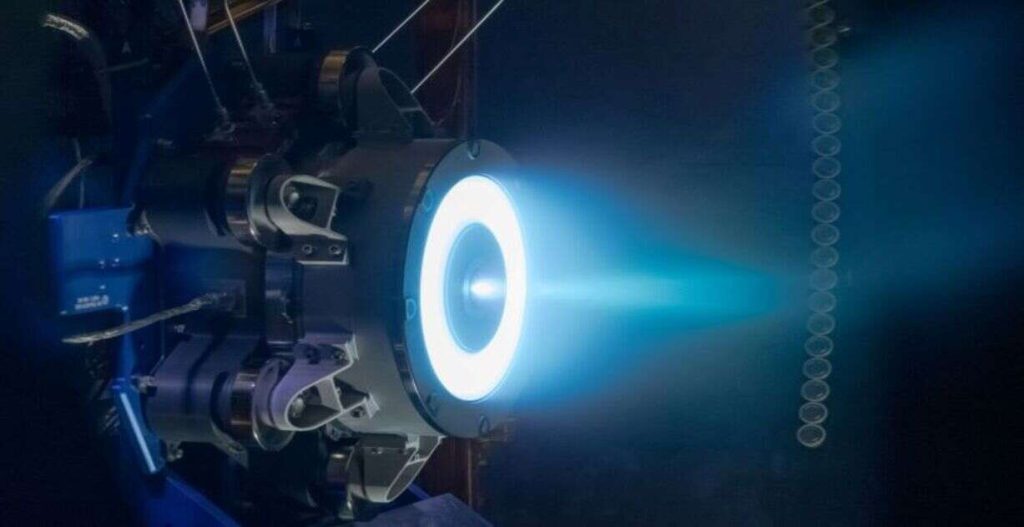Electric thruster

Electric thrusters operate on the principle of ion propulsion, where they use electricity to generate thrust. The most common type is the ion thruster, specifically the Hall-effect thruster. Here’s a step-by-step breakdown of its working:
Ionization of Propellant: The process begins by introducing a propellant, often an inert gas like xenon, into the thruster’s ionization chamber. High-energy electrons, generated by an electric power source, collide with the propellant atoms, stripping them of electrons and turning them into positively charged ions.
Magnetic Field Generation: A magnetic field is then created within the thruster, typically using magnets or electromagnets. This magnetic field serves to confine and accelerate the generated ions.
Acceleration of Ions: The positively charged ions experience a force within the magnetic field, causing them to accelerate away from the ionization chamber. As they move towards the exit of the thruster, they pass through a set of grids that further accelerate and expel them at high speeds.
Generation of Thrust: The expulsion of ions creates a reaction force, known as thrust, in the opposite direction. This thrust propels the spacecraft forward. While the force generated by a single ion is small, the high velocity of the expelled ions collectively results in significant propulsion.
Advantages of Electric Thrusters:
- Fuel Efficiency Champions: Compared to chemical rockets, electric thrusters achieve a much higher “specific impulse.” This means they travel farther on much less fuel, making them the marathon runners of the engine world. Think of it as crossing the entire country on a single tank of gas!
- Endurance Athletes: Unlike chemical rockets that burst with short bursts of power, electric thrusters can operate continuously for months or even years. They’re like the workhorses of the space world, ideal for deep space missions or keeping satellites in orbit like faithful guardians.
- Precision Control: Forget brute force! Electric thrusters offer delicate control, allowing for precise maneuvers like docking with spacecraft or exploring asteroids. Think of it as using a feather instead of a sledgehammer to move a delicate object.
- Clean and Green: No combustion means no harmful emissions, making electric thrusters a more environmentally friendly choice for space travel. They’re like the electric cars of the cosmos, leaving a cleaner trail in their wake.
Applications:
- Deep Space Explorers: Electric thrusters power probes like New Horizons, venturing beyond the solar system and unveiling the secrets of distant worlds.
- Orbital Guardians: They’re the silent heroes behind satellites, keeping them in their precise orbits to ensure uninterrupted communication and Earth observation.
- Spacecraft Ballerinas: From adjusting the orientation of telescopes to fine-tuning a spacecraft’s trajectory, electric thrusters offer the gentle touch needed for delicate maneuvers.
Electric thrusters, the fuel-efficient engines revolutionizing space travel, come in various flavors, each with its own strengths and specialties. Let’s dive into the three main types, exploring their mechanisms and applications:
1. Gridded Ion Thrusters (GIT):
Mechanism: GITs are the workhorses of the electric thruster family. They use an elaborate grid system to ionize and accelerate propellant. Electrons bombard neutral gas atoms in the discharge chamber, stripping them of electrons and creating positively charged ions. These ions are then drawn towards the negatively charged grid, gaining immense speed as they pass through its accelerating channels. Finally, they shoot out of the thruster nozzle, generating thrust.
Applications: GITs are versatile engines, powering deep space probes like NASA’s Dawn mission to the asteroid belt and Ceres. They’re also used for station keeping of satellites and spacecraft attitude control.
2. Hall-effect thrusters:
Mechanism: These thrusters rely on a fascinating magnetic field phenomenon called the Hall effect. A strong magnetic field confines electrons near the propellant gas, creating an invisible “wall” that prevents them from directly striking the ions. This forces the electrons to drift sideways, creating an electric field that accelerates the ions towards the thruster exit.
Applications: Hall-effect thrusters are known for their high efficiency and thrust-to-weight ratio. They’re often used for satellite propulsion and in-space maneuvering, including the European Space Agency’s GOCE satellite mission to study Earth’s gravity.
3. Electrothermal Thrusters:
Mechanism: Unlike GITs and Hall-effect thrusters, electrothermal thrusters don’t rely on ion acceleration. Instead, they heat the propellant (often xenon) to extremely high temperatures using an electric current. This superheated gas expands rapidly and shoots out of the nozzle, generating thrust.
Applications: Electrothermal thrusters are simpler and lighter than ion thrusters, making them suitable for smaller satellites and CubeSats. They’re often used for attitude control and orbit adjustments.
Bonus: Magnetohydrodynamic (MHD) Thrusters:
Mechanism: These futuristic engines are still under development but hold immense potential. They use powerful magnetic fields to directly accelerate ionized propellant, achieving incredibly high exhaust velocities and potentially exceeding the capabilities of conventional electric thrusters.
Bonus
Magnetohydrodynamic (MHD) Thruster
Applications: MHD thrusters have the potential to revolutionize interstellar travel, enabling faster and more efficient missions to deep space destinations. However, significant technological challenges remain before they become a reality.
Choosing the right electric thruster depends on various factors like mission requirements, spacecraft size, and fuel efficiency needs. Each type offers unique advantages and drawbacks, making them valuable tools in the ever-expanding toolbox of space propulsion. As research and development continue, we can expect even more advanced and efficient electric thrusters to emerge, pushing the boundaries of what’s possible in the vast cosmos.
I hope this explanation offers a well-rounded understanding of the different types of electric thrusters and their fascinating mechanisms. Feel free to ask any further questions you might have!


